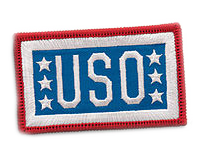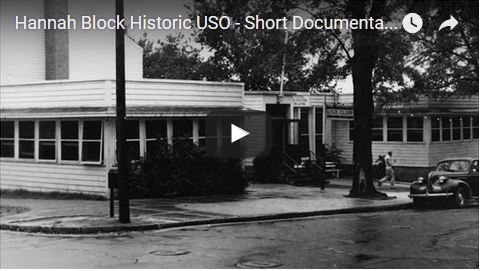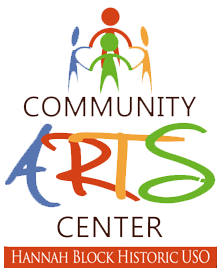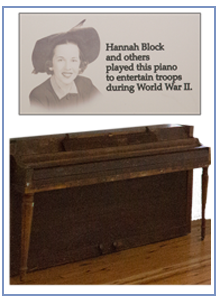The Historic USO
| Hannah Block Historic USO BuildingHundreds of thousands of armed forces personnel that trained in the Wilmington area during World War II made the USO Center, located at the corner of Second and Orange Streets in downtown Wilmington, their principal off-duty destination.
Today the building is a major cultural resource for New Hanover County and is a historic landmark for southeastern North Carolina. |
 |
|

Service members from the Army antiaircraft artillery base at Camp Davis in Holly Ridge, the Marine training facility at Camp Lejeune in Jacksonville, the Army airborne center at Fort Bragg in Fayetteville, and many other installations came to the USO facility for dancing, recreation and entertainment. From 1941 to 1945, the community hosted visitors in uniform at the rate of 35,000 every week. To help local citizens handle this enormous challenge, the federal government constructed two civic centers for use by the United Service Organizations, Inc. A nonprofit voluntary agency, still in existence today, the USO supported military families through social programs and entertainment. It also provided activities for defense workers in industries such as the North Carolina Shipbuilding Company, which built Liberty ships on the Cape Fear River, and the Ethyl-Dow Chemical Plant in Kure Beach, which manufactured an additive used in gasoline. The Second and Orange USO Club was erected by the Army Corps of Engineers at a cost of $80,000. Along with an identical structure on Nixon Street for African-American servicemen, it opened in December 1941, the same month that the Japanese attacked Pearl Harbor. The USO eventually operated nine full-time centers in New Hanover County, including clubs in Wilmington, Wrightsville Beach, and Carolina Beach. Five smaller facilities brought the total to 14. One center was built in Southport in Brunswick County. The club was run by four charitable agencies affiliated with the USO: the YMCA, YWCA, National Jewish Welfare Board, and National Travelers Aid Association. Volunteers kept the building open 24 hours a day, seven days a week. At the height of the war, attendance reached 63,000 per month. Typical events included big band dances, plays, music recitals, art exhibits, hobby shows, guest lectures, wedding receptions, and weekly radio broadcasts. On weekend nights, 600 men crowded into the basement dormitory. A help desk provided assistance in locating accommodations for temporary visitors. The canteen in the lobby dispensed the two commodities for which the USO was most renowned − coffee and doughnuts. When the USO ended its full-time operations in 1946, the city of Wilmington purchased the building for use by the Department of Recreation, now known as Parks and Recreation. Renamed the Community Center, it presented daily programs for children and young adults. Groups such as the Thalian Association Community Theatre, founded in 1788, and Wilmington College, the predecessor of UNCW, also utilized the facility. In 1948, the Community Center hosted the opening ceremony of the First Azalea Festival. Founded by Hugh Morton and Dr. W. Houston Moore, the Festival drew 75,000 visitors to Wilmington to witness such scenic attractions as Greenfield Lake, Airlie Gardens, and Orton Plantation. Major events included a downtown parade and the coronation of the Azalea Queen by Governor R. Gregg Cherry. On the morning of April 9, a crowd of 2,000 people assembled in front of the Center to hear renowned ABC news commentator, Ted Malone, deliver a special edition of his national radio program, which was carried by 275 stations and enjoyed a loyal following estimated at 25,000,000. The ceremony marked the appearance of the Azalea Queen, RKO starlet Jacqueline White, whom Malone introduced to the cheering throng. By the 1960’s, the focus of activities had shifted from recreation to the arts, which had entered a phase of renewed growth. The Arts Council of the Lower Cape Fear made its first headquarters here. In 1973 the city renamed the building the Community Arts Center in recognition of its changing mission. The following year, it was placed on the National Register of Historic Places. Today, the center, which is managed by the Thalian Association Community Theatre, is a major cultural resource for New Hanover County. Classes are offered in a variety of visual and performing arts disciplines and the building is home to the acclaimed Orange Street Potters. The building also hosts crews for movies, television shows and commercials, while hundreds of citizens vote here each Election Day. The building is also provides rehearsal space to local nonprofit theater companies. The auditorium, which hosts plays and musicals by local theater companies, was dedicated as the Hannah Block Second Street Stage in 1997 in honor of one of Wilmington’s most distinguished civic leaders and WWII veterans. The building itself was rededicated in Ms. Block’s name in 2006 and restored to its 1943 wartime character in 2008. Our wonderful building is listed in the National Register of Historic Places. The World War II Wilmington Home Front Heritage Coalition, an all-volunteer 501(c)(3) preservation organization, is the de-facto preservationist of the building’s history and maintains the home front museum. For more than half a century, the Hannah Block Historic USO Building has facilitated the coming together of generations, providing children with programs that challenge them creatively, and enhancing the quality of life of residents throughout the region. As Wilmington Magazine enthused, “The spirit and purpose that called it into being still reside within its walls.” This history was prepared by Dr. Everard H. Smith. ABOUT OUR NAMESAKE
|
||


